Prior to today, I'd not heard of wabi-sabi (侘寂). It sounds a bit like wasabi, and I do know that that is a Japanese sauce made from the root of the wasabi plant. But this wabi-sabi thing...
Debra Lee Baldwin, book author and contributing writer at Gardening Gone Wild, introduced me to the concept in her recent post, Wabi-sabi in the garden. If you break the word down into its literal translation, it is something like this: Wabi is something that evokes a feeling of rustic simplicity and understated elegance. Sabi is that which can be seen as beautiful and serene by virtue of its visible imperfections due to natural aging or necessary repair.
"It (wabi-sabi) nurtures all that is authentic by acknowledging three simple realities: nothing lasts, nothing is finished, and nothing is perfect." - Richard R. Powell
While I can think of many things this can be applied to, I'll be honest in saying the first thing that comes to mind to me personally are those crow's feet that decorate my eyes. The youthful look to my skin didn't last, my skin is not done wrinkling, and my skin sure isn't perfect. But I like this idea of using the term wabi-sabi to describe it. Makes it sound it's a desirable characteristic that I've now achieved. Yay me!
Back to the garden though...
Debra shows what wabi-sabi means to her in the provocative photos she posted and she challenged her readers to slow down and see the imperfect, yet beautiful, in our fading gardens. On this lovely, sunny fall day, I welcomed the opportunity to look beyond the brown leaves and bare spots.
 The first killing frost of the season came early this morning. Two light frosts earlier didn't faze anything in the gardens except for newly emerging Elephant Ear leaves, but this one was more than the remaining annuals could take. Yet the shades of pink and orange remaining in this 'California Giants' Zinnia are nearly as stunning as they were in their prime.
The first killing frost of the season came early this morning. Two light frosts earlier didn't faze anything in the gardens except for newly emerging Elephant Ear leaves, but this one was more than the remaining annuals could take. Yet the shades of pink and orange remaining in this 'California Giants' Zinnia are nearly as stunning as they were in their prime.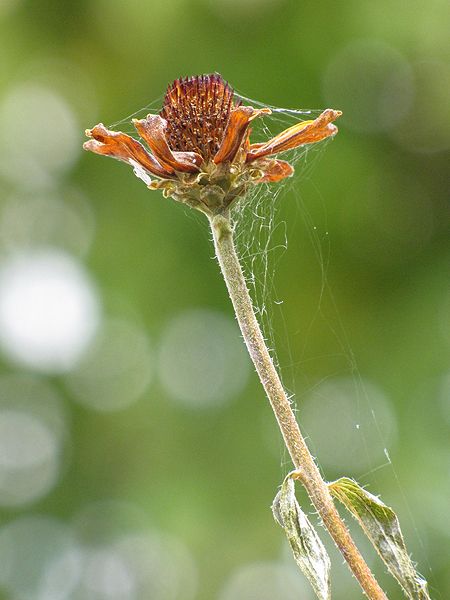 Another Zinnia, 'Chippendale,' has long been dried on the stem, but it still serves a useful purpose to our spidery friends and the seeds contained in the head will be food for birds. If I collect the seeds, it means these Zinnias will live on next year, when I plant them again. It's the circle of life portrayed in many ways. You thought it was a dead flower.
Another Zinnia, 'Chippendale,' has long been dried on the stem, but it still serves a useful purpose to our spidery friends and the seeds contained in the head will be food for birds. If I collect the seeds, it means these Zinnias will live on next year, when I plant them again. It's the circle of life portrayed in many ways. You thought it was a dead flower.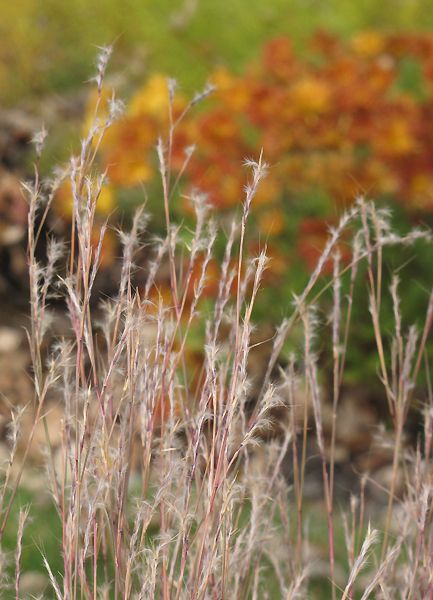 Little Bluestem Grass (Schyzachirium scoparium) was planted last fall and has really done well this year. There is such grace and beauty in its flaxen feathers, wafting to and fro in the breezes of autumn.
Little Bluestem Grass (Schyzachirium scoparium) was planted last fall and has really done well this year. There is such grace and beauty in its flaxen feathers, wafting to and fro in the breezes of autumn.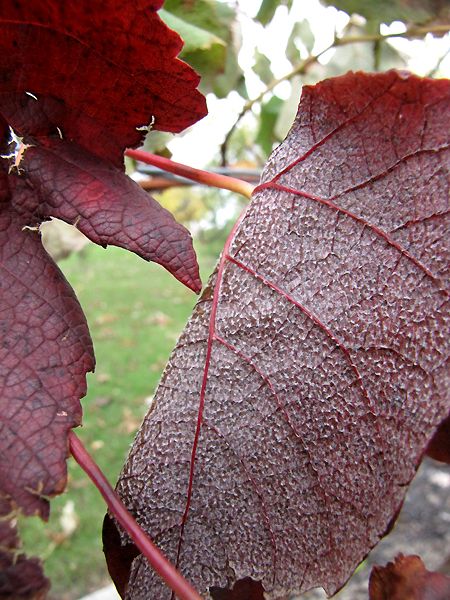 Amazingly, the 'Mars' grape (Vitis vinifera) vines turn a deep wine shade in the fall, echoing the color of the grapes it bore earlier in the season. Hmmm...do leaves have crow's feet, too?
Amazingly, the 'Mars' grape (Vitis vinifera) vines turn a deep wine shade in the fall, echoing the color of the grapes it bore earlier in the season. Hmmm...do leaves have crow's feet, too?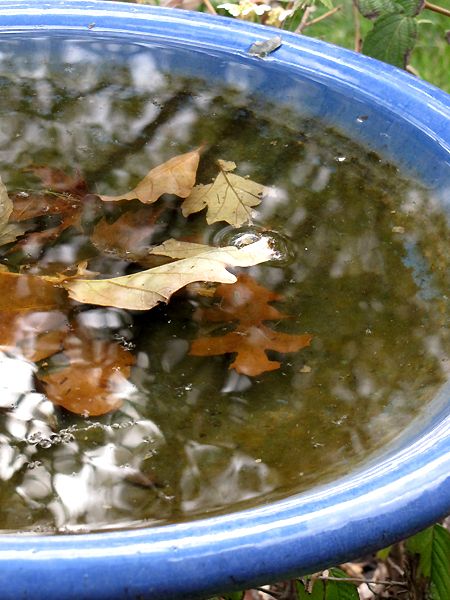 The blue bird bath is used more by the cats for a drink than for bathing birds. In the fall, the leaves from the oak and maple trees find their way into it, making cleaning a regular task. The contrast of the cobalt with the browns of oak catch my eye, but my thoughts also turn to the rich organic nutrients in the water, which I'll pour on the plants below when I clean it once again.
The blue bird bath is used more by the cats for a drink than for bathing birds. In the fall, the leaves from the oak and maple trees find their way into it, making cleaning a regular task. The contrast of the cobalt with the browns of oak catch my eye, but my thoughts also turn to the rich organic nutrients in the water, which I'll pour on the plants below when I clean it once again.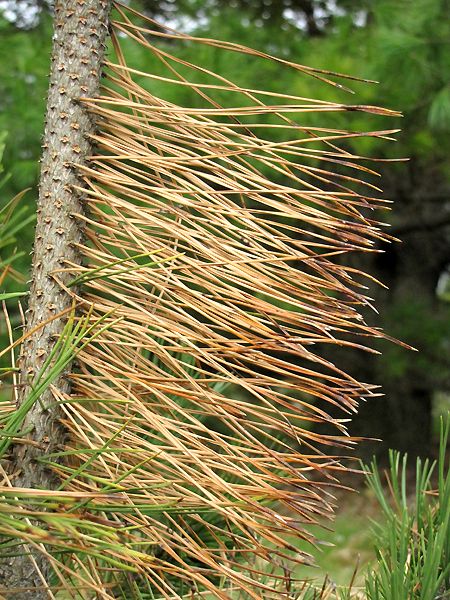 Though the Austrian Pine (Pinus nigra) tree remains evergreen through the winter, it always loses some needles along the main trunk when autumn comes. In just days, these will fall, providing a soft bed of mulch at its feet.
Though the Austrian Pine (Pinus nigra) tree remains evergreen through the winter, it always loses some needles along the main trunk when autumn comes. In just days, these will fall, providing a soft bed of mulch at its feet.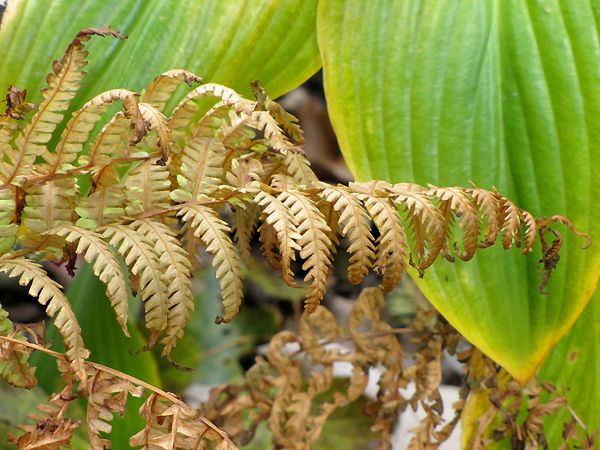 In the dry summers, I struggle to keep the Ostrich Ferns (Matteuccia struthiopteris) moist enough to sustain their large fronds. By fall, no amount of water will keep them from turning brown and going to sleep for the winter. Still, they're graceful and elegant with their zig-zaggy form.
In the dry summers, I struggle to keep the Ostrich Ferns (Matteuccia struthiopteris) moist enough to sustain their large fronds. By fall, no amount of water will keep them from turning brown and going to sleep for the winter. Still, they're graceful and elegant with their zig-zaggy form.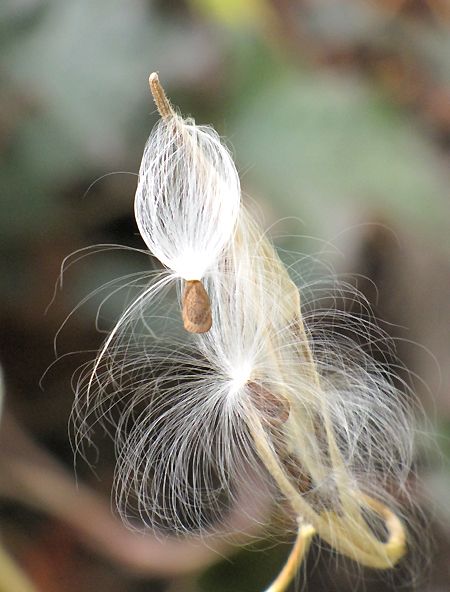 The Milkweed (Ascepias tuberosa 'Hello Yellow') erupts into glorious silken seeds that become airborne when the dried pods burst open. The Monarch butterflies will be happy to see the new plants that will result next summer and be home to their offspring.
The Milkweed (Ascepias tuberosa 'Hello Yellow') erupts into glorious silken seeds that become airborne when the dried pods burst open. The Monarch butterflies will be happy to see the new plants that will result next summer and be home to their offspring.Thank you, Debra, for introducing me to wabi-sabi and compelling me to search out and find it in my own garden. It was a good day.
















 "Bejeweled"
"Bejeweled"



8 comments:
Beautiful shots. The first photo, of the "failing" Zinnia is, wabi-sabi aside, perfect.
The texture and color of the 'Mars' grape leaves are stunning. As a child, we called the tiny seeds and puff of fluff from the milkpod...fairies. Your photo shows tiny fairies getting ready to cast themselves into the wind. Wonderful photos!
Interesting post about wabi-sabi. This post of yours contains some beautiful images including Mars grapes, zinnia and above all my favorite plant milkweed. thanks for sharing.
Kylee you gave me the first giggle of the day talking about your crows feet being wabi-sabi. I so agree with you though. Your garden has lots of sabi about it. Cheers.
Great way to think of things Kylee. Embrace things as they are.
Love the photos. I love the look of seed pods.
I don't think gardeners could be gardeners without accepting imperfection or seeing the beauty in the landscape in all seasons. :) It always amazes and annoys me when people rush over to point out one imperfection.
What a wonderful post, Kylee. I think wabi-sabi may become my favourite new way of looking at the world around me. A lot of wisdom there, for sure.
Loved this post Kylee. I'm having a bit of a hard time seeing wabi-sabi in my garden these days. Our new patio and walks look great, but the construction rubbish piled here and there in the garden, and all the plants chewed down by rabbits while I was at my Mom's a few weeks ago are a little hard to see beyond. Tomorrow I'm going out there to find some wabi-sabi amidst the mess! Thanks for the inspiration - I can use some about now!
Post a Comment